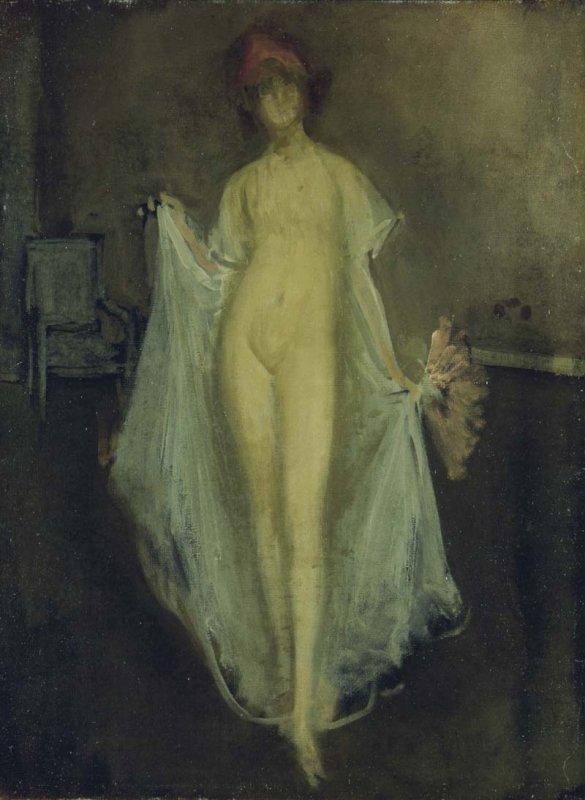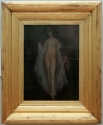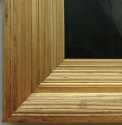Home > Catalogue > Browse > La Sylphide << >>
Composition
Variations on the pose are seen in drawings by Whistler. The pose, in reverse, is similar to that in Green and Blue: The Dancer [M.1376], dated ca 1893. Although the legs are further apart, another comparable pose is seen in a later pastel, A girl in a red cap [M.1468].
Technique
The measurements of the canvas correspond to the French 'toile de 12' and it has a very open plain weave typical of Whistler’s canvases acquired in Paris. There is a thin white priming on the canvas, presumably a commercial one, and a thinly applied mid-grey imprimatura.
A full technical examination of this painting was carried out in the School of Culture and Creative Arts Technical Art History laboratory in the Hunterian at Kelvin Hall in February 2020. Professors Joyce H. Townsend and Margaret F. MacDonald examined the paintings under a microscope. A high resolution camera for infra-red reflectography (IRR) was operated by Tess Visser, a PhD student supervised by Professor Christina Young, assisted by Alicia Hughes, Hunterian curatorial assistant; images were also made of the recto in normal, raking, and ultraviolet light, and of the verso. The results are summarised below.
The infrared reflectogram does not give any evidence for underdrawing, which would, if done in graphite pencil, have been discernible through such thin paint. Neither does it show any compositional changes. Raking light images also indicate that the paint is thin throughout.
The composition is a tonal study, with the draped figure placed first, on the dark grey imprimatura that would later serve for the floor without further painting. Then the warmer pink walls were lightly painted, with the brushstrokes following her outline. The drapery was further defined, with later pink brushstrokes reinforcing the warmth of the flesh seen through the fabric. The gauzy fabric, though it is sketchy, has its lower border clearly and economically defined by a continuous stroke of grey paint, that reads almost like a pure white against the darker background colours of the room. Bone black can be seen under magnification in all the paint, including this “white”, and the flesh tones.
The fan was painted at a later stage and relatively thickly, and the skirting board that defines the interior space even later: it runs up to the fan, not under it. The chair at left was first painted as a dark flat shape using thinned dark grey paint, then given form and more presence with lighter grey brushstrokes in the same paint used for the skirting board. The first light brushstrokes for the flesh paint are surprisingly grey when viewed under magnification, and were applied at the same time as the drapery. The pearly skin tones were then built up with thin applications of lighter, warmer pink paint that includes a very pale pink organic pigment, rather than the redder ochres Whistler often used to depict flesh paint if he used a less dark background colour or imprimatura. Red vermilion is absent too: pinks and greys define the composition even at the microscopic level, in a carefully constructed colour harmony.
There are numerous signs of alterations: the drapery, for instance, originally extended further left. Her head is small in relation to her body, with curiously abbreviated features, and is unconvincingly positioned in relation to her neck.
The face is unfinished, the last working having consisted of rubbing down. The hair was painted with a long-haired and soft brush, which gives a feathery outline to the paint. Elsewhere, it is obvious that 6.5mm (¼ inch) brushes were used, one for each colour: black, cap colour, fan, pale grey for the drapery, flesh colour, and the colour of the right arm seen through gauzy fabric. The pink cap was relatively thickly painted, and the pinkish background colour behind it was rubbed or washed away round it to make the colour stand out in the composition. Some details were added boldly: the hem of the cape, for example, is outlined in a broad wavy brushstroke.
There are microcracks at the top of a few canvas threads, suggesting very light abrasion, and only light rubbing down for the flesh paint. In the more diaphanous fabric, there is light rubbing down, removing small amounts of paint but not so much as to reveal the tone of an earlier brushstroke. Separate long brushstrokes made with a soft long-haired brush have marbled very slightly, suggesting thinner or medium modifier was added to this paint. (Thinner makes paint look matte, and was clearly used here, whereas medium modifier serves to bring back the natural sheen of oil-based paint.)
Conservation History
The varnish is of natural resin type, fairly evenly brushed. It covers the whole sight area, and hence was not applied in a frame. It is not much yellowed. It overlies Whistler’s butterfly signature, and appears to be the earliest varnish applied since no conservation treatment is known to have occurred. But since the canvas was not exhibited in his lifetime, it could nonetheless have been applied posthumously.
Frame
A Grau-style frame, dating from ca 1900. 1 Size: 92.2 x 76.9 x 7.6 cm.
Last updated: 8th April 2021 by Margaret











